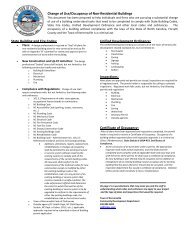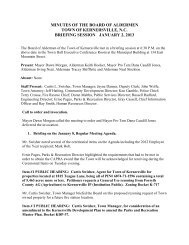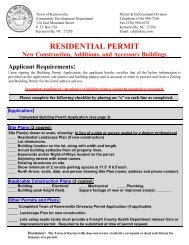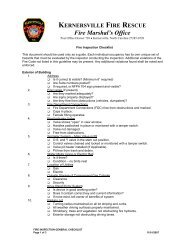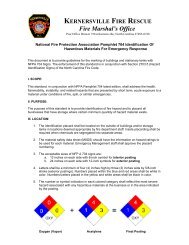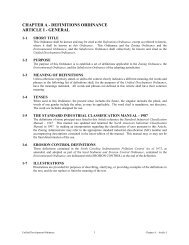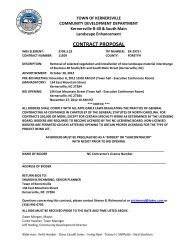Tree Maintenance - 52 Things You Can Do for Your ... - City of Durham
Tree Maintenance - 52 Things You Can Do for Your ... - City of Durham
Tree Maintenance - 52 Things You Can Do for Your ... - City of Durham
Create successful ePaper yourself
Turn your PDF publications into a flip-book with our unique Google optimized e-Paper software.
<strong>Tree</strong> <strong>Maintenance</strong> - <strong>Do</strong>n't Top <strong>Tree</strong>s<br />
Topping is severely cutting limbs larger than 3" in diameter to stubs within the tree's crown so as to<br />
remove the normal canopy and disfigure the tree.<br />
Reasons not to top:<br />
Starvation<br />
Good pruning practices rarely remove more than 1/2 to 1/3 <strong>of</strong> the crown, which in turn does not seriously<br />
interfere with the ability <strong>of</strong> a tree's leafy crown to manufacture food. Topping removes so much <strong>of</strong> the crown that it<br />
upsets an older tree's well-developed crown-to-root ratio and temporarily cuts <strong>of</strong>f its food-making ability.<br />
Shock<br />
A tree's crown is like an umbrella that shields much <strong>of</strong> the tree from the direct rays <strong>of</strong> the sun. By<br />
suddenly removing this protection, the remaining bark tissue is so exposed that scalding may result. There may<br />
also be a dramatic effect on neighboring trees and shrubs. If these thrive in shade and the shade is removed, poor<br />
health or death may result.<br />
Ugliness<br />
A topped tree is a disfigured tree. Even with its regrowth it never regains the grace and character <strong>of</strong> its<br />
species. The landscape and the community are robbed <strong>of</strong> a valuable asset.<br />
Rapid new growth<br />
The goal <strong>of</strong> topping is usually to control the height and spread <strong>of</strong> a tree. Actually, it has just the opposite<br />
effect. The resulting sprouts (<strong>of</strong>ten called water sprouts) are far more numerous than normal new growth and they<br />
elongate so rapidly that the tree returns to its original height in a very short time - and with a far denser crown.<br />
Insects and disease<br />
The large stubs <strong>of</strong> a topped tree have a difficult time <strong>for</strong>ming callus. The terminal location <strong>of</strong> these cuts, as<br />
well as their large diameter, prevents the tree's chemically based natural defense system from doing its job. The<br />
stubs are highly vulnerable to insect invasion and the spores <strong>of</strong> decay fungi. If decay is already present in the limb,<br />
opening the limb will speed the spread <strong>of</strong> the disease.<br />
Cost<br />
To a worker with a saw, topping a tree is much easier than applying the skill and judgment <strong>of</strong> good<br />
pruning. There<strong>for</strong>e, topping may cost less in the short run. However, the true costs <strong>of</strong> topping are hidden. These<br />
include: reduced property value, the expense <strong>of</strong> removal and replacement if the tree dies, the loss <strong>of</strong> other trees<br />
and shrubs if they succumb to changed light conditions, the risk <strong>of</strong> liability from weakened branches, and increased




